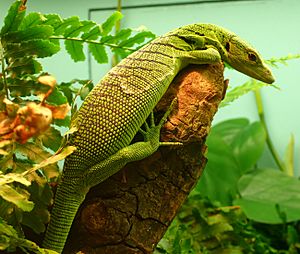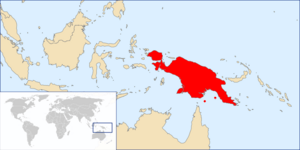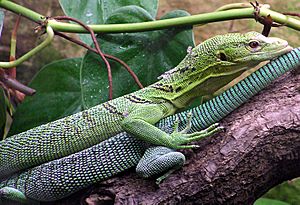Emerald tree monitor facts for kids
Quick facts for kids Emerald tree monitor |
|
|---|---|
 |
|
| Conservation status | |
| Scientific classification | |
| Genus: |
Varanus
|
| Species: |
prasinus
|
 |
|
| Distribution of the emerald tree monitor, shown in red. | |
The emerald tree monitor (Varanus prasinus), also called the green tree monitor, is a small to medium-sized monitor lizard. It spends most of its life in trees, which is why it's called "arboreal."
This lizard is famous for its amazing colors. It can be bright green or even turquoise. It also has dark stripes across its back. These colors help it hide perfectly among the leaves in its tree home. Because of its beautiful look, the emerald tree monitor is very popular in the pet trade and in zoos.
Contents
What's in a Name?
In the Kalam language of Papua New Guinea, this lizard is known as wbl km.
Understanding Its Family Tree: Taxonomy
The emerald tree monitor was first described in 1831 by John Edward Gray. He called it Monitor viridis. However, the original specimen he used was lost. So, eight years later, in 1839, Hermann Schlegel described it again and gave it the name Varanus prasinus.
The name Varanus comes from the Arabic word waral. This word means "monitor" in English. The second part of its name, prasinus, is a Latin word that means "green."
The emerald tree monitor belongs to a group of lizards called Euprepiosaurus. It is closely related to several other monitor lizards that also live in trees. These lizards are often grouped together and called the V. prasinus species group. All the lizards in this group live in different places and do not overlap.
Some of its close relatives include:
- V. beccarii from the Aru Islands
- V. boehmei from Waigeo Island
- V. bogerti from the D'Entrecasteaux Archipelago
- V. keithhornei from the Cape York Peninsula
- V. kordensis from Biak Island
- V. macraei from Batanta Island
- V. reisingeri from Misool Island
- V. telenesetes from Rossel Island
How Emerald Tree Monitors Evolved
The family of lizards called Varanidae (which includes all monitor lizards) likely started in Asia about 65 million years ago. Some scientists think they might be even older, possibly from 112 million years ago. Monitor lizards probably moved to Australia and the Indonesian islands between 39 and 26 million years ago.
All the members of the V. prasinus group are found east of a special imaginary line called Lydekker’s line. This group likely first appeared in the Moluccas. It's hard to know exactly when they evolved because there are not many fossils. One reason this group might have spread so much in the Australo-Papuan region is that there were no large predatory mammals east of another imaginary line called Wallace's line.
Where They Live: Distribution
Emerald tree monitors and their relatives can be found in New Guinea (which includes parts of Indonesia and Papua New Guinea). They also live on several nearby islands and in the northern Torres Strait Islands.
These green lizards love living in warm, wet places. They thrive in lowland areas like tropical evergreen forests, palm swamps, and even cocoa plantations.
What They Look Like: Description

The emerald tree monitor is usually about 75 to 100 centimeters (30 to 39 inches) long. It has a very thin body. This slender shape helps it balance easily on narrow tree branches.
It has a special tail that can grip things, like a monkey's tail. This is called a prehensile tail. Along with its long claws, its tail helps it hold onto branches tightly. Unlike many other monitor lizards, the emerald tree monitor protects its tail. It won't whip its tail around for defense if it feels threatened. The bottoms of its feet have large scales that help it climb even better.
Their Lifestyle: Ecology
If an emerald tree monitor feels threatened, it will usually try to run away through the plants. But if it gets trapped, it will bite to defend itself.
These lizards are quite unique because they are one of the few social monitors. They often live in small groups. These groups usually have one main male, a few females, and some other males and younger lizards.
What They Eat: Diet
The emerald tree monitor's diet mainly includes large insects and other creatures that live in trees. This includes katydids, stick insects, cockroaches, beetles, centipedes, spiders, and even crabs. They also eat birds and small mammals.
When they catch stick insects, they tear off the legs before swallowing them. In zoos, these lizards have been seen tearing the limbs off rodents before eating them. This means they can swallow surprisingly large prey. For example, a 135-gram (about 4.8 ounces) lizard was seen eating a 40-gram (about 1.4 ounces) rodent. That's almost one-third of its own weight! Some experts have also seen emerald tree monitors eating fruit, like bananas, when they are in captivity.
Life Cycle and Reproduction
Female emerald tree monitors lay up to five eggs at a time. Each egg weighs about 10.5 to 11.5 grams (0.37 to 0.41 ounces) and is about 2 by 4.5 centimeters (0.79 by 1.77 inches) in size. They can lay as many as three clutches of eggs throughout the year. Eggs have been laid by captive lizards in January, March, April, November, and December.
The female lizard lays her eggs inside termite nests in trees. The eggs hatch after about 160 to 190 days, usually between June and November. As soon as the young lizards hatch, they start eating the termites and their eggs that are inside the nest. They become ready to have their own babies when they are about one year old.
See also
In Spanish: Varano esmeralda para niños


